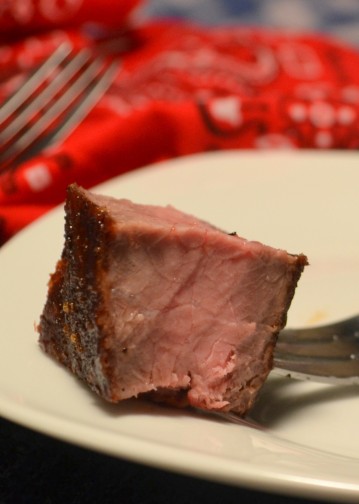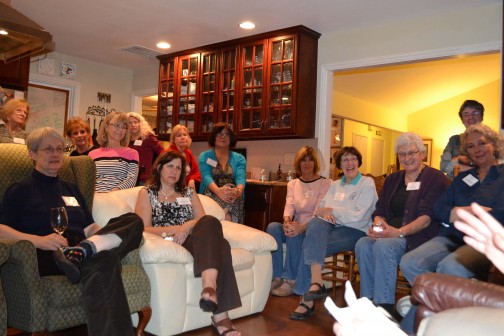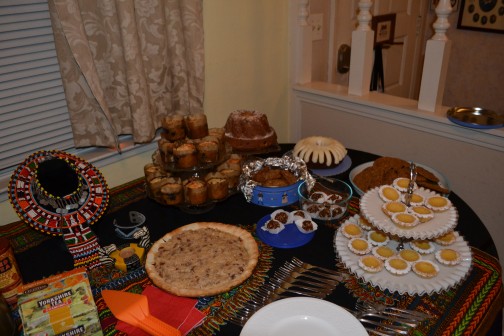Last weekend I had a Wild West themed party at my house. I suggested to my friends that they come dressed as cowgirls, and they did! They moseyed on over to the Bar –the Trail Mix Bar– to fill their saddlebags with snacks and quenched their thirst at the watering hole. I wanted the dinner to be Wild West themed, too, and steak immediately jumped to mind as the perfect main dish (I was later to find out that cowboys rarely ate steak, oops!). Nevertheless, before steak enlightenment, I set out to find out how to cook steak for twelve, quickly, accurately and indoors in February! It was easier than I ever imagined, and more successful, too. After steak enlightenment, I was so excited about this easy, easy way to cook delicious steak that I decided to put it on my Wild West menu anyway. I also served BBQ drumsticks, onion rings, cornbread with a delicious maple-orange butter, and roasted veggies. OK, so the menu wasn’t exactly authentic, but it did have a Wild West feel to it 🙂 Also, in preparation for this Wild West dinner, I made place mats out of old blue jeans and bought red bandannas to use as napkins!
Now, for the steak. Buy some really thick steaks. I used rib-eyes, but any kind is fine as long as the steaks are thick…, over one-inch thick! When you get the steaks home, dry age them. This is a crucial step so buy the steaks early in the week. Take the plastic wrap off the steaks, place them on a rack, and set them in the refrigerator, uncovered, for up to five days. That’s right, put the steaks on a (baking) rack (with a tray underneath) in the refrigerator, uncovered, for a few days. THIS, my friend, is the first half of the equation of a delicious steak. The second half of the equation is the cooking method in the recipe below. This recipe includes the Cowboy Steak rub I used on my steaks, but you can use any favorite rub, it’s the dry-aging process and cooking process that are important.
For most cowboys, even for the heartiest meat lovers, one-half of a thick rib steak is probably a good serving size. I served my cowgirls one-third of a steak each. So with that in mind, your 4 thick steaks, with side dishes, will serve 4 football players, 8 men/boys, or 12 lightweights/small women/teenage girls.
Gunpowder Polly’s Wild West Cowboy Steaks
(cooked in a modern indoor kitchen)
- 2 teaspoons kosher salt
- 1 teaspoon black pepper
- 1 teaspoon Hungarian sweet paprika (regular or smoked paprika can be substituted)
- 1 teaspoon garlic powder (can substitute onion powder, if you don’t have garlic powder)
- 1 teaspoon favorite dried herb, many people like thyme, I prefer basil, some like oregano…put in what you like
- 1 teaspoon ground cumin
- ½ teaspoon smoked ancho chili powder (or any other chili powder)
- 1 teaspoon finely ground coffee beans
- 4 thick bone-in rib eye steaks ( 1 ¼” to 1 ½ thick; each steak weighing 12 to 16 ounces)
- Buy your steaks and dry age them in the refrigerator for up to five days. Remove the steaks from the package. Place them on a rack. Place a tray under the rack to catch any possible drips. Place the steaks, rack and tray in the refrigerator, uncovered, for up to 5 days.
- One or two hours before you want to start cooking, remove steaks from refrigerator and bring to room temperature.
- Mix all rub ingredients –salt, pepper, paprika, garlic powder, dried green herb, cumin, chili powder, and ground coffee– in small bowl. Sprinkle approx ½ teaspoon of rub mixture over each side of the steaks, press and rub mixture into meat. Let steaks stand at room temperature 1 hour.
- Preheat the oven to 425°.
- Get out an oven safe frying pan large enough to fit all steaks (or use two frying pans), put 1T-3T olive oil in the bottom of the frying pan/s and heat (on the stove) until the oil is smoking (but don’t let the oil burn) and the pan is very, very hot.
- Keep heat under the pan on high, or medium high if there appears to be imminent danger of fire, and add the steaks to the hot pan. Do not touch the steaks for the next five minutes. Let steak cook on high for exactly five minutes.
- Turn the heat off. Quickly turn the steaks over. Place the still hot pan–with the steaks still in it–into a hot oven. Close the oven door and set the timer for five minutes.
- Remove the steaks and pan from the hot oven. Transfer the steaks to a cutting board, cover lightly with foil, and let sit for ten minutes before cutting or serving.
- Serve! You’ll be amazed at how easy it was to cook the perfect medium rare steak. Your guests will love, love, love the texture and taste of the steak. Look at THIS!
My daughter made these delightful cookies for dessert, so fun and tasty! Check her out at Party Girl Cookies or on Facebook 🙂
Here are a few more pictures from my Wild West party, yeeeeHAW!
Thanks for stopping by my Wild West kitchen today! I hope this recipe becomes a staple in your kitchen, it definitely has in mine 🙂









